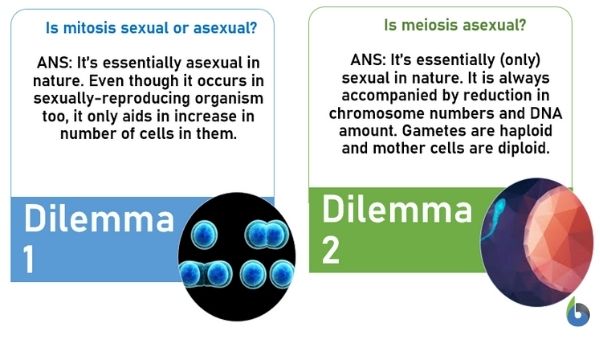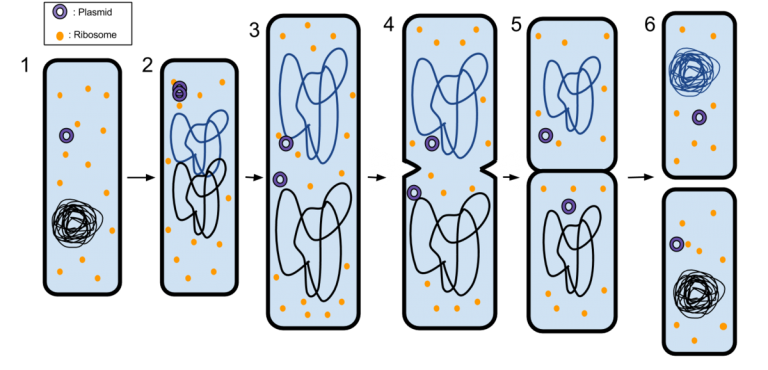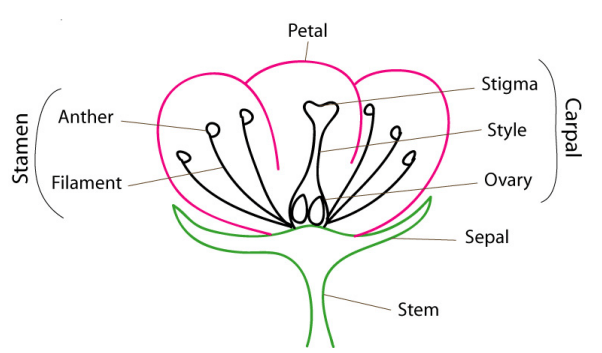Biology Forum › Community › General Discussion › Asexual and sexual reproduction- differences!
- AuthorPosts
- August 4, 2021 at 10:54 pm #118429
 Akanksha SaxenaParticipant
Akanksha SaxenaParticipantLet’s discuss reproduction 🙂
For the continuation of any species, it’s important that it leaves more individuals of its kind before it dies. This is taken care of by an essential life process called reproduction. Reproduction is a replicative biological process that aids in the production of one or more individuals that can ensure the continuation of a species down the evolutionary line. There are majorly 2 types of reproduction namely; sexual and asexual. This classification is based upon occurrence or lack of “fertilization event”. In order to understand what is asexual and sexual reproduction, we first need to get a little clarity on what are sexual and asexual characteristics of any organism.

Figure 1: Differences between sexual and asexual characteristics. Source: Akanksha Saxena of Biology Online
Organisms that reproduce asexually don’t have lives focused onto luring in another organism for producing more of its kind because it is self-sufficient in doing that, while sexually-reproducing organisms invest a huge chunk of their lives to fulfill that goal.
Do you agree with that thought that asexual organisms (kind of) have a simpler life??? What’s your thought about this!! Leave your comments below.👇👇
Asexual Reproduction Definition
In Biology, the definition of asexual reproduction goes by “a type of reproduction in which there is no energy investment in the processes of gamete formation and fusion; rather a simple clone formation process from one single parent”. Asexual organisms lack these time and energy-expending steps.
Do you know how much energy goes into it??😲💪🏻The genotype and the phenotype of the asexual organisms are not subject to any change down the evolutionary timelines because every reproductive event is just “one single parent” producing single/multiple progenies with the same genetic constitution. Now that we know how to define asexual reproduction, let’s look at sexual reproduction.
Sexual Reproduction Definition
When asked to define sexual reproduction in Biology, it is “a type of reproduction in which there is a huge energy investment in the processes of gamete formation and fusion; moreover, fertilization process endows the offspring with a newly-constituted genotype as well as phenotype”. There are 2 parents involved in sexual reproduction, who equally contribute to the process of production of next generation offspring/progenies.
If we are asked to define offspring/s or progenies, “they are the product of reproduction”.Now that we know how to define asexual and sexual modes of reproduction, can you answer “if we can call products of both types of reproduction as offspring/progenies”? What is your opinion???🧏🏻 🧏🏻♂️
Reproduction: Asexual vs. Sexual
Although there are occurrences of some similarities between sexual and asexual reproduction like:
- Both aid in inheritance of genes, traits, and chromosomes from the parental generation to progenies.
- Both help in the vital step of species continuation.
- Both aid immensely in progeny production.
But when we see an overall picture, they are 2 processes which are poles apart. Before listing points for asexual vs sexual reproduction, let’s first understand the 2 major types of cell divisions; mitosis and meiosis.
- Mitosis is an “equational division process” that results in the production of daughter cells with the same amount of genetic material as the parent cell. It occurs in both sexually and asexually-reproducing organisms.
- Meiosis (find an interesting tutorial on meiosis!!) is a “reductional division process” that results in the production of daughter cells with half the amount of genetic material as the parent cell. It occurs only in sexually-reproducing organisms.

Figure 2: Types of divisions in sexual and asexual organisms. Source: Akanksha Saxena of Biology Online
Now to understand two major dilemmas if- Is mitosis sexual or asexual? Is meiosis asexual? Look at the illustration below!

Figure 3: Illustration explaining the nature of 2 divisions. Source: Akanksha Saxena of Biology Online
Now let’s look at the differences between sexual and asexual reproduction and see what and which organism can reproduce asexually or sexually or both?
Characters Asexual Reproduction Sexual Reproduction Mode? What is asexual reproduction?
A mode of reproduction involving somatic cells’ replication, their division by mitosis, and a clone formation.What is sexual reproduction?
A mode of reproduction involving 2 gametes- 1 male and 1 female, their fusion and a zygote formation with new genetic constitution.Numbers of parents involved One Two Number of progenies produced Generally many Generally, less in number Gamete formation and fusion (fertilization) No Yes Presence Majorly in lower groups of organisms Majorly in higher group of organisms Basic element of reproduction Any asexual part of the organismal body (Somatic cells) Gamete/s (Germ cells) Type of division involved Mitosis
(So when asked “does asexual reproduction require meiosis”, answer is NO!!)Both mitosis and meiosis (Characteristic feature is meiosis though!!) Genotypic or phenotypic changes None (no scope) A lot (many) Advantages Advantages of asexual reproduction are: Quick & fast
Less energy & time investment
Exact replica/clone of parent produced
Makes organism able to survive even in hostile conditions (no mate availability)Advantages of sexual reproduction are: Genes are subject to recombination, reshuffling, intermixing and crossing over.
New abilities and capabilities are bestowed upon the offspring due to new genotypes.Disadvantages Disadvantages of asexual reproduction are: Lack of introduction of variations, hence lack of ability to deal with ongoing issues the parent organism is facing.
Disadvantages of sexual reproduction are: Time-consuming
Energy-exhaustingTypes/Forms Forms of asexual reproduction: Fission (binary/multiple), Fragmentation, Budding, Spore formation, Regeneration, Tuber/Runner/Bulb formation, Parthenogenesis, Apomixis, Vegetative reproduction Types of sexual reproduction:
There is only one type of sexual reproduction called “syngamy”. Although genetic recombination also happens in some lower organisms by “conjugation”- a process analogous to sexual reproduction but that’s not a sexual mode.Asexual reproduction examples
Asexual reproduction is widely seen across the prokaryotes, some cases in protozoans/fungi/plant groups/animal groups and never in humans. There are some examples of asexual plants and asexual animals too.

Figure 4: Examples of asexual reproduction in various lineages. Source: Akanksha Saxena of Biology Online
Another dilemma might have arisen here if turmeric or ginger reproduce just asexually? Answer to that is NO. They have rhizomes which serve as means of asexual reproduction, but, they also produce male (pollens) and female (egg) gametes in the flowers that lead to sexual reproduction… Isn’t it interesting that such plants possess both means to multiply more of their own kinds…?? 🌱🌿

Figure 5: Asexual reproduction via vegetative bud in Kalanchoe leaf. Source
In bacteria
Bacteria reproduce asexually by binary fission. The parent cell divides into identical progeny cells. Both daughters are exact replicas of the mother cell.

Figure 6: Binary fission in bacteria. Source
Parthenogenesis in rock lizards
Rock lizards are mainly reproducing via parthenogenesis i.e. embryo development occurs from eggs without the intervention of fertilization steps. It can occur due to the occurrence of polyploidy in these lizards’ genomes; either full-cloning of the mother lizard happens or half-cloning!
Sexual reproduction examples
Sexual reproduction is widely seen in eukaryotes. Plants, animals, fungi and all humans reproduce via this mode.
Sexual reproduction in animals
In animals, sexual reproduction is of 2 major types based on the site of gamete fusion; internal and external fertilization. Internal fertilization happens in mammals (eg: humans, cows, dogs, elephants, etc) where the gamete fusion happens after copulation and a fixed gestation period is involved. While in external fertilization, both male and female counterparts release their gametes into the external environment for fertilization (eg: toads, frogs, fishes).
There are some animals that produce both the gametes (male as well as female) … Now where do we place these and how do they reproduce… sexually or asexually? What do you think???Sexual reproduction in plants
In plants, sexual reproduction takes place by the fusion of male and female gametes. Most plant species are monoecious i.e. produce both types of gametes. A flower is the reproductive part of a plant possessing gynoecium (carpel)-stigma, style, ovary (with egg cell/female gamete)- female reproductive part and androecium (stamen)-filament and anthers with pollens (male gamete) -male reproductive part. There can be different types of pollination in plants- self-pollination (autogamy and geitonogamy), cross- pollination (allogamy).

Figure 7: Illustration showing gynoecium and androecium. SourceFrequently asked questions
How is asexual reproduction different from sexual reproduction?
Asexual reproduction takes places with no role of gamete fertilization step while gamete fertilization is the most vital step of sexual reproduction. Asexual reproduction comprises only mitosis type of division with no change in chromosome number or DNA amount. While sexual reproduction comprises both mitosis and meiosis type of division with change in chromosome numbers as well as DNA amount.
Why is sexual reproduction better than asexual?
Sexual reproduction is better than asexual reproduction because it involves introduction of new variations every time gamete formation and fertilization steps occur. This helps in intermixing, recombination and shuffling of genetic constitution and generation of new genetic make-ups in progeny.
What are disadvantages of sexual reproduction?
Sexual reproduction calls for a lot of energy and time-investment. Gamete production, mating as well as gestation periods are complicated steps in sexual reproduction. Sexually-reproducing organisms can’t help a population/species in extreme, hostile conditions where fast reproduction is needed and less energy needs to be expended in reproductive processes.
What are the different types of asexual reproduction?
Different types of asexual reproduction are Fission (binary/multiple), Fragmentation, Budding, Spore formation, Regeneration, Tuber/Runner/Bulb formation, Parthenogenesis, Apomixis, Vegetative reproduction
What is vegetative propagation?
Vegetative propagation is a type of asexual reproduction in plants. This happens by different propagule parts like rhizomes in ginger and turmeric, bulbs in onion and garlic, leaf adventitious buds in Bryophyllum, etc.
You might want to learn more about asexual and sexual reproduction. Comment below if you have any questions and I’d be happy to share with you my views. 😃😄😁
- August 6, 2021 at 7:35 am #118444
 Dushyant Pratap SinghParticipant
Dushyant Pratap SinghParticipantInteresting! Nicely sumped up.
- August 8, 2021 at 10:05 pm #118446
 Abhishek KanojiaParticipant
Abhishek KanojiaParticipantNice explanation
- August 9, 2021 at 6:57 am #118456
 Akanksha SaxenaParticipant
Akanksha SaxenaParticipantThanks Abhishek🌞
- August 9, 2021 at 6:57 am #118455
 Akanksha SaxenaParticipant
Akanksha SaxenaParticipantThanks man😁
- August 14, 2022 at 10:31 pm #219245
 paan jiParticipant
paan jiParticipant<span class=”ILfuVd” lang=”en”><span class=”hgKElc”>Sexual reproduction involves the fusion of male and female gametes whereas asexual reproduction does not require male and female individuals and no fusion of gametes takes place.</span></span>
- AuthorPosts
You must be logged in to reply to this topic.






